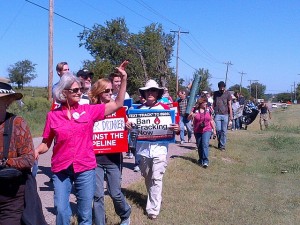Why Protesters Have a Hard Time Making Case Against the Keystone XL Pipeline
-
Joe Wertz
A Sept. 21 protest against the Keystone XL Pipeline attracted 74 people who walked a portion of the pipeline’s proposed route, The Journal Record reports.
The event, organized by the Oklahoma Chapter of the Sierra Club, was part of a national day of protest, and featured both local and regional activists and speakers who are worried about the dangers of the heavy crude oil the pipeline is designed to carry from the Canada’s tar sands to refineries on the Gulf Coast.
While the Oklahoma portion of the pipeline is nearing completion, the northern section still awaits a decision by President Barack Obama’s, which protestors are trying to sway. But the anti-Keystone XL efforts aren’t having the same policy effects that environmental activism in the 1960s did. What gives?
Reporter Sarah Terry-Cobo asked University of Oklahoma political science professor Keith Gaddie for some perspective:
In the 1960s, the environmental movement was battling visible air and water pollution: cities with thick smog and rivers so polluted that they burned. But it’s difficult to make a case against the Keystone pipeline, because people want cheap gasoline, he said.
“What happens when the public is sufficiently polarized?” Gaddie said. “To change minds or change policy with protests is tough.”
In order to have a lasting effect, the issue has to be easily accessible to the public, and many people think they understand oil in pipelines, he said. A pipeline rupture isn’t likely and the effects are very localized, which makes opposition to the Keystone pipeline a tough sell, he said. In this instance, activists are fighting long odds against established institutions. “They have to live for the hope they can turn the corner,” he said. “To effect real change you have to have no sense of proportion. Otherwise you become complacent.”


